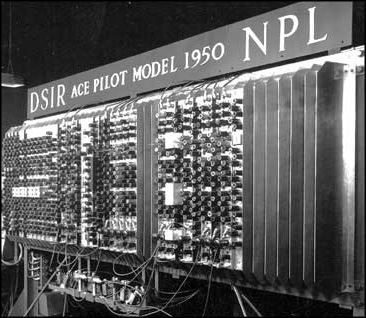|
|

|
 |
||||
|
|
|
Catalogue of digital facsimiles of historical documents concerning Turing's ACE
 |
The Pilot Model of the Automatic Computing Engine at the National Physical Laboratory
More
photographs of the Pilot Model ACE NPL photographs © Crown Copyright 1950. Reproduced by permission of the Controller of HMSO. |
Turing drew up the initial design for the Automatic Computing Engine in 1945. The design was approved by the National Physical Laboratory in 1946. Construction of the ACE proceeded slowly, and it was not until 10 May 1950 that the Pilot Model ran its first program. Turing himself had by this time left the National Physical Laboratory for Manchester University. The Pilot Model ACE was London's first electronic computer and the third stored-program computer to function in Britain. With a clock speed of 1 MHz it remained for some time the fastest computer in the world. DEUCE, the production version of the Pilot Model ACE, was built by the English Electric Company. In total more than 30 were sold. The NPL's full-scale ACE began work in 1958. The fundamentals of Turing's ACE design were employed by Harry Huskey (at Wayne University, Detroit) in the Bendix G15 computer. The G15 was arguably the first personal computer and over 400 were sold worldwide. DEUCE and the G15 remained in use until about 1970. Another computer derived from Turing's ACE design, the MOSAIC, played a role in Britain's air defences during the Cold War period.
The documents in this Archive are digital facsimiles of original NPL reports, minutes, and correspondence. The documents tell the story of Turing's computer from its inception.
Catalogue of digital facsimiles of historical documents concerning Turing's ACE
Turing Archive Catalogue || Catalogue of Reference Articles || The Turing Archive Homepage
Site maintained by Jack Copeland and Gordon Aston